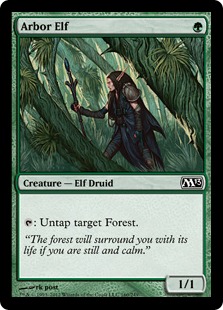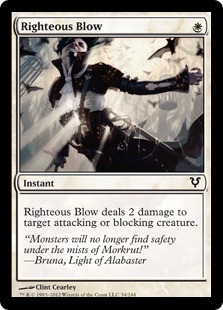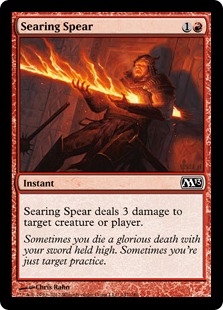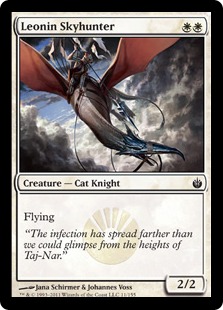Hello! This is the first part of my introduction to deck building in Magic: the Gathering. It's obviously aimed at beginning players, but I hope that anyone might be able to glean some interesting insights from it or find some useful ideas to add to their game knowledge.
This first part contains four sections:
1. Acquire the Right Cards
2. The Colours of Magic
3. Start with a Concept
4. Get Your Lands Right
#1. Acquire the Right Cards

Buying a ton of boosters is fun, but there are a couple of things you really need in order to build reasonable decks. The first, and most obvious, is a good supply of basic lands. Land cards are all-important in Magic. Without them, you won't be able to use any of your other cards. Most decks contain at least 20, usually around 24. More on that later. On top of that, it's quite important to have access to a supply of generically useful cards of various colours - the sort of cards you'll put in most decks that can make the appropriate kinds of mana. Giant monsters and esoteric spells are awesome, but at the end of the day - especially when you're starting out - your decks will need to generate mana, use it to summon creatures in a reasonably efficient way, and occasionally blow up something they don't otherwise feel like dealing with.
Fortunately, for the last few years, Wizards of the Coast have been publishing the Deckbuilder's Toolkit, essentially a box containing all of the above. It's very cheap, providing you with 100 lands and 185 other cards for a price usually somewhere around £15. I'd recommend them to any player looking to get into Magic. The cards are chosen to be friendly to new players while simultaneously giving plenty of options and hinting at some of the deeper aspects of the game. You can fully expect to crack one open and be able to put together a couple of decks.
Interestingly, I'd recommend getting two of them if you have the money to spare (there is, of course, no need to get both at once). A typical Toolkit contains a lot of single cards, with two of each of a few really ubiquitous ones.

Yeah, take that, spell.
Wizards also supplies pre-built introductory decks. These are good value, and of late, include two boosters as well as a complete 60-card deck. However, I'd actually recommend not getting those unless you already have a small supply of other cards. Two boosters might give you a couple of cards worth using to customise the supplied deck, but it's not really a full deckbuilding experience, and won't give you room for creativity. Conversely, the intro decks are a great way to get hold of useful cards if they happen to fit a deck you're already trying to build, or a good starting point for a deck of your own if you have enough stuff to put in. Buying pre-built decks is great for being able to just sit down and play the game, but won't take you anything beyond that by themselves.
There are other options besides buying cards, if you're unwilling or unable to do so. If you have friends who play, you could do worse than to ask if you could have a go at building something out of their spares. They may well even talk you through the process of doing it, and having someone to hand with useful opinions on the quality of cards is a good way to jump-start your own knowledge of the game. (Magic has a lot of cards, and not all of them are easy to evaluate just through reading.) Many experienced players will have boxes of literally thousands of cards they aren't currently using, and asking to borrow sixty of them ought not to be unreasonable.
#2. The Colours of Magic

White: White is the colour of the many. Cooperation, law, armies, and religion are all part of white's repertoire. At its best, white is selfless and just; at its worst, it's oppressive and traditionalist. White has the best complement of small creatures, and the largest number of them, compared to the other colours. It has good (if conditional) answers to opposing threats, plenty of ways of making creatures bigger, and handy combat-centric abilities like first strike, vigilance, lifelink, and flying.
Blue: Blue is the colour of the mind. It values intelligence and knowledge above might or glory. At its best, blue is reflective and wise; at its worst, it's single-minded and cold. Blue cards tend to affect the game on a more abstract level than the other colours. Counterspells, returning cards to an opponent's hand, dumping your opponent's library into his graveyard, and tapping creatures to neuter them are all abilities that don't care too much about what a creature is. Most of blue's creatures are relatively weak; blue can defend itself more than adequately with other spells. Blue likes to draw cards, which can generate a resource advantage for it.
Black: Black is the colour of the self. It looks out for number one above all else, with amorality and survival of the greatest being the maxim. Any means to achieve the desired end will do. At its best, black is ambitious and strong-willed; at its worst, it's selfish and cruel. Black's willingness to do whatever it takes to win results in it having lots of good ways to kill other creatures, huge demons, cards that force your opponent to discard cards from their hand, virulent poisons, and so on. A mono-black deck can play pretty much any way it wants to.

BURN.
Green: Green is the colour of nature. It seeks to preserve the old ways and resist change or technology. At its best, green is noble and communal; at its worst, it's archaic and narrow-minded. Green has the biggest, smashiest creatures, from rhinos to enormous wurms, and the best mana acceleration (generating more mana, more quickly) and mana-fixing (providing access to desired colours of mana). To make up for these amazing benefits, it lacks almost anything else. A mono-green deck typically tries to get out oversized creatures as quickly as possible to create threats the opponent cannot adequately deal with, before the opponent does the same. Green's mana-fixing means it is by far the colour most comfortable with being mixed with others; many decks of three or more colours lean on a green component in order to get their mana bases working.
Many people start their Magic careers with monocoloured decks. It's easy to say "I'm going to build a white deck", slap your 36 favourite white cards together with some Plains, and go. This is a great way to start playing and introduce yourself to both deckbuilding and the Magic colour wheel, and I heartily recommend doing it. Of course, if it was the entirety of the game this guide wouldn't exist, which leads me to...
#3. Start with a Concept
You've bought, borrowed or otherwise acquired some cards. Now what? I find that it helps to begin with what you actually want the deck to do. Almost any decent deck can be summarised in a sentence, regardless of how complicated it is. For instance, my two most involved decks can still be described simply: "profits from the deaths of creatures" and "built around the abilities of Ghave, Guru of Spores". Without a clear goal in mind, your deck is unlikely to be that effective, and sticking to a concept is extremely helpful, as it lets you make all sorts of decisions easily and up-front.
If this sounds awfully high-level and complex, fear not! As I mentioned in the previous section, when you have a small collection, it's often tempting to say "I'm going to make a green deck", pile up some green cards and Forests, and call it a day.

Green decks like this guy.
An archetypical green deck probably includes big, smashy creatures, such as Duskdale Wurm. Do you plan on winning with those creatures? If so, how do you intend to get them out reliably and reasonably quickly? (Hint: that mana acceleration stuff I mentioned earlier is really rather pleasant.) Do you plan on defending yourself against flying creatures or removal? Are you bringing answer cards, such as Naturalize or Plummet, or do you want to keep the deck space open for more creatures? It's worth spending a moment to refine your concept in accordance with your answers.
This process works with any concept. I decided to make my "profits from the deaths of creatures" deck after encountering the card Blood Artist. Well, how am I meant to cause deaths? I guess I could use removal cards like Tragic Slip to kill my opponent's things, but that's not quite reliable enough. What if I use creatures with sacrifice abilities, like Viscera Seer? And creatures that can be sacrificed multiple times, like Butcher Ghoul? And what about Pawn of Ulamog, which lets me effectively sacrifice any of my creatures twice by spawning a token creature each time one of my real creatures dies? Suddenly, building from the concept, I have the bones of the deck. The deck has gone through many iterations since then, but all of the cards I just mentioned are still in it.

Putting together a good tribal deck requires a reasonably-sized pool of cards, since you'll need access to a lot of the right sort of creature, but they tend to 'just work'. Vampires are probably the easiest tribe to start with; there are tons of good Vampire cards (the Deckbuilder's Toolkit contains a fair few), and since Vampires live in red and black, you have access to the vast majority of Magic's best instant-speed removal spells. Humans are possibly the most difficult due to their versatility; Human creature cards are everywhere throughout Magic and you can build a Human deck more or less any way you want it, but as a result you lose out on the handy 'put this in!' cards belonging to other tribes, such as Drogskol Captain and Feast of Blood, and it's much less obvious how to build "a Human deck" since there isn't a standard way to do it.
Here's another example. I love dragons, so I want to build a dragon deck. Dragons. That's a concept right there. (A tribal one, at that.) So, obviously, this deck wants to summon, attack with, and win the game with dragons. Dragons are red, so this'll be a red deck of some kind. Air defence shouldn't be an issue; I have a bevy of 5/5 and 6/6 flying creatures that'll happily beat up birds, drakes and even angels. Being outnumbered, on the other hand, might prove to be an issue, so I'd better take some cards that can blow up a lot of opposing creatures at once. Conveniently, I pulled two copies of Mizzium Mortars from boosters the other day, so I'll leave room in the deck for them. The main problem with dragons is that, being so large, they're very expensive. Few cost less than five mana, and most of the coolest ones hit seven or eight. So I'm going to want to accelerate mana, which typically comes from green cards. As such, I'm going to mix in some green, making a red-green deck. This means that I can be slamming a Balefire Dragon onto the table when the best thing my opponent has is a Canyon Minotaur.
I hope the example makes it clear how, by asking the right questions, you can extrapolate the shape of your deck from even the simplest, one-word concepts. Of course, there's plenty of room for changing your mind later, and there's nothing that really compares to looking through a huge pile of cards for potential inclusions or that one spell that perfectly fixes a vulnerability, so don't feel pressured to get it all perfect straight away.
#4. Get Your Lands Right
To do almost anything in Magic, you need lands. When you start playing, it's very tempting to put 20 lands in your deck and forget about it. After all, using 24 lands would reduce the amount of other stuff you can squeeze in, right?
The problem is that if you aren't generating enough mana to cast the things in your hand, it doesn't matter how cool they are - they'll never get to do anything. And if you don't draw enough lands, chances are you won't generate enough mana. On the other hand, you don't want to be mana-flooded too often, where you're sitting there drawing lands... and lands... and lands... and you're starting to run out of blockers... So, it's important to have enough lands, but not too many.
There's no hard and fast rule for the number of lands you're including, but here's a reasonable approximation (which I use myself) to get you started:
- If your deck doesn't need to go above three mana, use around 20.

- If your deck doesn't need to go above four mana, use around 22.
- Otherwise, use 24.
- If you want to consistently hit six or more mana, consider mana acceleration.
There are, of course, many reasons why you wouldn't want to stick with this basic estimate. There's nothing wrong with using mana accelerators in a fast, 20-land deck; being able to slam down a Leatherback Baloth on the second turn after a first-turn Llanowar Elves is quite a nice trick to have at your disposal. You might be playing a slow deck that defends itself and limits your opponent's options, drawing out the game, and earning you time to draw more lands and play larger creatures. You might be drawing a ton of additional cards, which will pull lands into your hand along with everything else. If all your deck wants to do is play creatures and hit stuff, though, it's a reasonable rule of thumb.
Another thing to be aware of is the colour balance of your deck. At first blush, the balance between Stormfront Pegasus and Leonin Skyhunter might seem a little off. They cost the same amount of mana, but the Skyhunter is clearly better, owing to its toughness of 2. The difference is that the Skyhunter requires two white mana, whereas the Pegasus only needs one. This means that to be able to reliably cast the Skyhunter on turn two, you need to be able to reliably generate two white mana on turn two. This isn't necessarily easy if you're playing a deck with more than one colour in it. Elite Inquisitor, Predator Ooze and Phyrexian Obliterator are all amazing cards, but summoning the three of them in a row on the turns they're meant to be summoned is going to be difficult to say the least.

See this? Use them.
If you're playing multiple colours, and especially if you're planning on using cards with more than one coloured mana symbol in their costs, it's useful to have a good balance of colours as well as the overall amount of mana. If you have twice as many green mana symbols as blue ones in the mana costs of your cards, then you'll want around twice as many things that can generate green mana as a starting point. You might also want to use so-called 'mana fixing' cards, which can generate different kinds of mana depending on what you need. They might be able to add any colour of mana to your pool (Transguild Promenade, Alloy Myr or Vessel of Endless Rest), generate a choice of two or three colours in an efficient way (Sunpetal Grove or Rakdos Keyrune), or search up a land of your choice from your deck (Borderland Ranger, Rampant Growth or Evolving Wilds). Evolving Wilds in particular is a card I put in every single multicolour deck I build - usually between one and three of them. You might notice that a good number of these examples also double as mana acceleration, letting you move ahead of the one-land-a-turn restriction or increasing reliability.
Comments